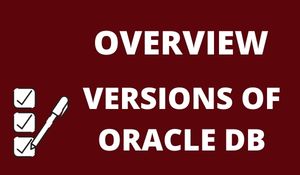
Oracle Database also called Oracle DB is a relational database management system (RDBMS) from Oracle Corporation. Originally developed in 1977 by Lawrence Ellison and other developers, Oracle DB is one of the most trusted and widely used relational database engines for storing, organizing, and retrieving data by type while still maintaining relationships between the various types. The system is built around a relational database framework in which data objects may be directly accessed by users or an application front end through structured query language (SQL). Oracle is a fully scalable relational database architecture and is often used by global enterprises that manage and process data across wide and local area networks. The Oracle database has a network component to allow communications across networks.
Databases are used to provide structure and organization to data stored electronically in a computer system. Before they were adopted, early computers stored data in flat file structures where information in each file was separated by commas (CSV files). However, as the number of fields and rows that defined the characteristics and structure of each piece of data continued increasing, it was only a matter of time before this approach would become unmanageable.
Relational models for database management represented the ideal solution to this issue by organizing data in entities and attributes that further describe them. Today, Oracle Database represents the RDBMS with the largest market share. Oracle DB rivals Microsoft’s SQL Server in the enterprise database market. There are other database offerings, but most of these command a tiny market share compared to Oracle DB and SQL Server. Fortunately, the structures of Oracle DB and SQL Server are quite similar, which is a benefit when learning database administration.
Oracle DB runs on most major platforms, including Windows, UNIX, Linux, and macOS. The Oracle database is supported on multiple operating systems, including IBM AIX, HP-UX, Linux, Microsoft Windows Server, Solaris, SunOS, and macOS.
Oracle started supporting open platforms such as GNU/Linux in the late 1990s. Different software versions are available, based on requirements and budget. Oracle DB editions are hierarchically broken down as follows:
Enterprise Edition: Offers all features, including superior performance and security, and is the most robust
Personal Edition: Nearly the same as the Enterprise Edition, except it does not include the Oracle Real Application Clusters option
Standard Edition: Contains base functionality for users that do not require Enterprise Edition’s robust package
Express Edition (XE): The lightweight, free, and limited Windows, and Linux edition
Oracle Lite: This is for mobile devices
A key feature of Oracle is that its architecture is split between the logical and the physical. This structure means that for large-scale distributed computing, also known as grid computing, the data location is irrelevant and transparent to the user, allowing for a more modular physical structure that can be added to and altered without affecting the activity of the database, its data, or its users.
The sharing of resources in this way allows for very flexible data networks with capacity that can be adjusted up or down to suit demand, without degradation of service. It also allows for a robust system to be devised, as there is no single point at which a failure can bring down the database since the networked schema of the storage resources means that any failure would be local only.
The largest benefit of the Oracle DB is that it is more scalable than SQL, which can make it more cost-efficient in enterprise instances. This means that if an organization requires a large number of databases to store data, they can be configured dynamically and accessed quickly without any periods of downtime.
| Learn more information from GoLogica “ORACLE DBA 11g/12c TRAINING“ |
Oracle Big Data: Improved Database Services for Big Data
Oracle Big Data is an improved database service from the globally acknowledged brand for maintaining huge data. With Oracle’s big data, data professionals can easily manage, catalog, and process raw data. Also, they can utilize offered object storage and Hadoop-based data lakes for data persistence even after the program gets terminated. Whereas, Spark resolves the issues of seamless data processing and Oracle Cloud SQL handles data analysis along with other analytics tools selected by the customers for their analysis ease.
A Breakdown of Oracle Versions
Version 11G
Released back in 2008, Version 11G is an older release of the Oracle database versions. This RDBMS has no pluggable databases. This Oracle version is considered very easy to install, develop, and manage. It has an intuitive browser-based interface that allows for built-in testing of database changes. This is a priceless feature that previous Oracle versions lacked.
Version 11G offers the ability to view tables back in time. It also provides superior compression of all data. This quality makes running reports much faster as the process uses less disk space. This version introduced the prized SQL developer that presents a graphical user interface tool for developers to more efficiently query, define, and control data.
Version 12C
In 2014, Oracle officially released Version 12C, which is the first in the C series. This high-performance RDBMS is designated with a C instead of a G as it’s the first version of Oracle designed to work on the Cloud. This Oracle version makes it super easy for businesses to transition their existing Oracle database information to the Cloud. Version 12C has introduced 500 new features into the Oracle Database. The most notable features are the pluggable databases and multitenant architecture.
Version 18C
Oracle Version 18C is one of the latest versions to be released as an autonomous database. This self-driving database is self-securing and self-repairing. Version 18C is available for the Oracle cloud or on-site premises. This version has started a new Oracle version naming structure based on its release year of 2018. Therefore, there are no releases between 12C and 18C.
Oracle Version 19C
The latest Oracle version, the 19C, was released in early January 2019. It’s been noted as the long-term release for the 12.2 product family of Oracle databases. This particular version will be supported through 2023, with extended support available until 2026.
Some of the newest features in the 19C release include:
Query Quarantine: Unlike previous Oracle versions, 19C solves the problem of overloading system resources with query requests. This version provides automatic query quarantine to ensure that specific queries aren’t running over and over.
JSON Support: This version has simplified the syntax for JSON functions and allows users the capability to do partial updates of JSON. In addition, it provides SODA APIs for Node.js, C, Python, and Java.
Automatic Indexing: 19C offers a machine-learning algorithm feature that provides constant index adjustment. This algorithm leads to enhanced system performance and more cost savings. After just a short amount of use, this database version will build indexes that allow for more efficient plans for each dataset.
Hybrid Partitioned Tables: This 19C feature permits database administrators to manage tables both inside and outside the database with ease. The partitions inside the database can easily be managed alongside partitions that are in read-only data stores outside of the database on the premises or the Cloud.
Active Data Guard: This new feature works to prevent downtime and data loss during database repairs and upgrades. It allows for incidental updates to be run while a synchronized physical replica or standby is maintained.
Related Courses
| Course Name | Enroll Now |
|---|---|
| ORACLE DBA 11g/12c TRAINING | Enroll Now |
| Oracle B2B Training | Enroll Now |
| Oracle BI Publisher Training | Enroll Now |
| Oracle Fusion SCM Training | Enroll Now |
| ORACLE SOA TRAINING | Enroll Now |
Author Bio

Kavya Sathvik, A content strategist at Gologica. She has 2 years of experience in content writing. Passionate about writing technical content and also creating an effective content strategy for brands and blogs. Contact her: Linkedin













